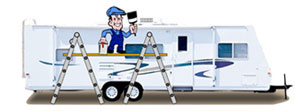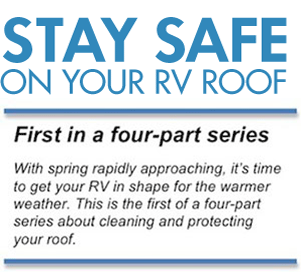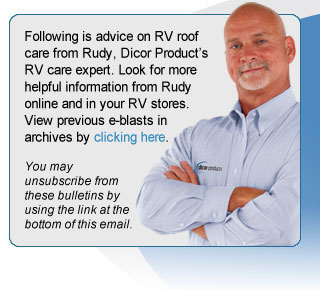 Use an appropriate height ladder. Some RVs have narrow ladders running up their backsides, but they have weight limitations you may not know. And particularly on older RVs, it's hard to know if these ladders are securely anchored. A regular ladder is a more solid, easier and safer bet. Even better, a simple scaffold can be arranged with a couple of stepladders and 2 x 8 planks. Use an appropriate height ladder. Some RVs have narrow ladders running up their backsides, but they have weight limitations you may not know. And particularly on older RVs, it's hard to know if these ladders are securely anchored. A regular ladder is a more solid, easier and safer bet. Even better, a simple scaffold can be arranged with a couple of stepladders and 2 x 8 planks.
|
||
| No, but you can damage it. If you want to actually go onto the roof, first feel it out to see how solid it appears for your weight. Rubber roofs are pretty solid, but you generally have no way of knowing what kind of substrate material has been used, which could be anything from 1/4-inch lauan to 3/4-inch plywood, or whether the trusses are 16- or 24-inch or otherwise centered. If you can feel some give to the roof when you push on it, that's likely the 1/4-inch lauan and you need to be even more careful. | ||
| To take care, at least at first, go out on your hands and knees to more evenly distribute your weight. If you can determine where they are, the cross members should be the first places you step on and keep stepping on. You can also lay 2 x 8 or 2 x 10 planks or smaller pieces of plywood on top of the roof for better weight distribution. | ||
 Before attempting to go on any roof, make sure it is not wet or slippery with any substance. If you do go up on your roof, make sure the soles of your shoes have no imbedded stones or debris that can damage the roof. Before attempting to go on any roof, make sure it is not wet or slippery with any substance. If you do go up on your roof, make sure the soles of your shoes have no imbedded stones or debris that can damage the roof. |
||
| Cleaning, coating and other maintenance activity often involves walking backwards as you brush, roll, spray or scrub. Always be aware of where you are as you move backwards. Those drop offs and roof vents can sneak up on you when you're not looking. So please be careful. Safety is job number one. Please always be careful and take your time to do it the safest way. And enjoy!
Next: Using the right cleaner the right way. |
||
You are receiving this email because you have asked to receieve industry related product and service announcements from Dicor Products. If you would no longer like to receive these emails you may unsubscribe at any time using the link below. |


